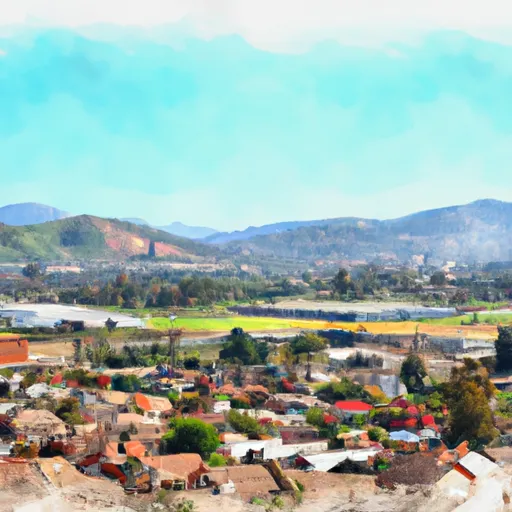-
 Snoflo Premium
Snoflo Premium
Get unlimited access to all our content
With no Ad interruptions! - Start Your Free Trial Login with existing account
Temecula
Eden Index
Climate
9.2
•
Recreation
6.1
•
Community
2.5
•
Safeguard
6.4/10

Temecula, located in Riverside County, California, is known for its Mediterranean climate characterized by hot, dry summers and mild, wet winters. The region experiences an average annual temperature of 70°F, making it a desirable destination for outdoor enthusiasts throughout the year.
Hydrologically, Temecula is positioned along the Santa Margarita River, which is an important water source for the area. Additionally, the region relies on imported water through the Metropolitan Water District of Southern California.
Temecula offers numerous outdoor recreation opportunities. The city boasts over 3,000 acres of open space and parks, including the Santa Rosa Plateau Ecological Reserve, where visitors can explore diverse habitats and enjoy hiking trails. The nearby Temecula Valley Wine Country is a popular attraction, offering wine tasting, vineyard tours, and picturesque landscapes. For adventure seekers, hot air balloon rides provide breathtaking views of the encompassing vineyards and rolling hills. Additionally, golfing enthusiasts can enjoy world-class golf courses, including the Temecula Creek Inn Golf Course.
Overall, Temecula’s pleasant climate, access to water sources, and abundant outdoor recreation options make it an ideal destination for nature lovers and those seeking an active lifestyle.
What is the Eden Index?
The Snoflo Eden Index serves as a comprehensive rating system for regions, evaluating their desirability through a holistic assessment of climate health, outdoor recreation opportunities, and natural disaster risk, acknowledging the profound impact of these factors on livability and well-being.
Climate Health Indicator (CHI): 9.2
Temecula receives approximately
472mm of rain per year,
with humidity levels near 46%
and air temperatures averaging around
18°C.
Temecula has a plant hardyness factor of
10, meaning
plants and agriculture in this region tend to thrive here all year round.
By considering the ideal temperature range, reliable water supplies, clean air, and stable seasonal rain or snowpacks, the Climate Health Indicator (CHI) underscores the significance of a healthy climate as the foundation for quality living.
A healthy climate is paramount for ensuring a high quality of life and livability in a region, fostering both physical well-being and environmental harmony. This can be characterized by ideal temperatures, reliable access to water supplies, clean air, and consistent seasonal rain or snowpacks.
Weather Forecast
Streamflow Conditions
Laguna-San Diego Coastal
Area Rivers
Laguna-San Diego Coastal
Snowpack Depths
Laguna-San Diego Coastal
Reservoir Storage Capacity
Laguna-San Diego Coastal
Groundwater Levels
Recreational Opportunity Index (ROI): 6.1
The Recreational Opportunity Index (ROI) recognizes the value of outdoor recreational options, such as parks, hiking trails, camping sites, and fishing spots, while acknowledging that climate plays a pivotal role in ensuring the comfort and consistency of these experiences.
Access to outdoor recreational opportunities, encompassing activities such as parks, hiking, camping, and fishing, is crucial for overall well-being, and the climate plays a pivotal role in enabling and enhancing these experiences, ensuring that individuals can engage in nature-based activities comfortably and consistently.
Camping Areas
| Campground | Campsites | Reservations | Toilets | Showers | Elevation |
|---|---|---|---|---|---|
| Oceanside Harbor | 40 | 14 ft | |||
| El Cariso | 24 | 2,568 ft | |||
| Del Mar Beach Military | None | 13 ft | |||
| South Carlsbad State Beach | 220 | 68 ft | |||
| Wildomar | 11 | 2,456 ft | |||
| Dixon Lake | 45 | 1,062 ft | |||
| Lake Skinner | None | 1,514 ft | |||
| San Elijo State Beach | 151 | 62 ft | |||
| Lake ONeill Military | None | 135 ft | |||
| Guajome Park | 35 | 103 ft |
Catastrophe Safeguard Index (CSI):
The Catastrophe Safeguard Index (CSI) recognizes that natural disaster risk, encompassing floods, fires, hurricanes, and tornadoes, can drastically affect safety and the overall appeal of an area.
The level of natural disaster risk in a region significantly affects safety and the overall livability, with climate change amplifying these risks by potentially increasing the frequency and intensity of events like floods, fires, hurricanes, and tornadoes, thereby posing substantial challenges to community resilience and well-being.
Community Resilience Indicator (CRI): 2.5
The Community Resilience Indicator (CRI) recognizes that education, healthcare, and socioeconomics are crucial to the well-being of a region. The CRI acknowledges the profound impact of these elements on residents' overall quality of life. By evaluating educational resources, healthcare accessibility, and economic inclusivity, the index captures the essential aspects that contribute to a thriving community, fostering resident satisfaction, equity, and social cohesion.

